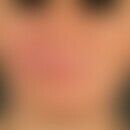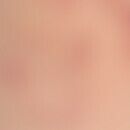DefinitionThis section has been translated automatically.
Keratosis palmoplantaris, periodontopathy,onychogryposis with mutation in CTSC gene, also called Haim-Munk syndrome, is a genetic, autosomal recessive inherited disorder characterized mainly by palmoplantar hyperkeratosis and periodontitis.
Occurrence/EpidemiologyThis section has been translated automatically.
HMS is rare, with fewer than 100 cases described in the literature to date. Most of the patients described are descendants of a few consanguineous families from a religious isolate in Cochin (India).
You might also be interested in
EtiopathogenesisThis section has been translated automatically.
HMS is caused by mutations in the CTSC gene, which are inherited in an autosomal recessive manner. In many cases, the affected persons are descendants of a consanguineous family from India.
ManifestationThis section has been translated automatically.
Keratosis usually develops in affected individuals between the ages of 1 and 5.
ClinicThis section has been translated automatically.
Haim-Munk syndrome (HMS) is characterized by palmoplantar hyperkeratosis, severe and early-onset periodontitis, onychogryposis, pes planus, arachnodactyly and acroosteolysis. in addition, scaly skin areas occur on the knees, shins, elbows and back of the hands. Deformities of the fingers (conical, tapered phalangeal ends and claw-like volar curvature) are characteristic. Periodontitis is severe and has an early onset, affecting even the deciduous teeth. It occurs in the accompaniment of gingivitis and alveolar bone resorption. Patients are very susceptible to infections
DiagnosisThis section has been translated automatically.
The diagnosis is based on the clinical findings and can be confirmed by the detection of the causative mutations. Differential diagnoses include other diseases with palmoplantar hyperkeratosis and prepubertal periodontitis.
TherapyThis section has been translated automatically.
Treatment of skin symptoms requires topical emollients, keratolytics (including salicylates and urea), and oral retinoids (acitretin, etretinate, and isotretinoin). Periodontitis in HMS is usually unresponsive to traditional therapies for periodontitis. Extraction of deciduous teeth in combination with oral antibiotics and professional dental cleaning may be helpful. Synovectomy reduced inflammation in destructive arthritis, but may result in limited joint mobility.
LiteratureThis section has been translated automatically.
- Giannetti L et al (2020) Papillon-Lefèvre syndrome: oral aspects and treatment. Dermatol Ther 33:e13336.
- Hacham-Zadeh S et al (1978) A genetic analysis of the Papillon-Lefevre syndrome in a Jewish family from Cochin. Am J Med Genet 2: 153-157.
- Haim S, Munk J (1965) Keratosis palmo-plantaris congenita, with periodontosis, arachnodactyly and peculiar deformity of the terminal phalanges. Brit J Derm 77: 42-54.
- Hart TC et al (2001) Haim-Munk syndrome and Papillon-Lefevre syndrome are allelic mutations in cathepsin C. J Med Genet 37: 88-94.
- Hart TC et al (1997) Genetic studies of syndromes with severe periodontitis and palmoplantar hyperkeratosis. J Periodont Res 32: 81-89.
- Moghaddasi M et al. (2021) The first case report of Haim Munk disease with neurological manifestations and literature review. Clin Case Rep 9:e04802.
- Pahwa P et al (2010) Haim munk syndrome. J Indian Soc Periodontol 14:201-203.
- Puliyel JM et al (1986) A syndrome of keratosis palmo-plantaris congenita, pes planus, onychogryphosis, periodontosis, arachnodactyly and a peculiar acro-osteolysis. Brit J Derm 115: 243-248.
- Smith P et al (1967) Seven cases of Papillon-Lefevre syndrome. Periodontics 5: 42-46.
Outgoing links (1)
CTSC Gene ;Disclaimer
Please ask your physician for a reliable diagnosis. This website is only meant as a reference.




